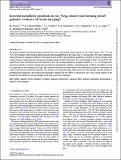Por favor, use este identificador para citar o enlazar a este item:
http://hdl.handle.net/10261/224313COMPARTIR / EXPORTAR:
 SHARE SHARE
 CORE
BASE CORE
BASE
|
|
| Visualizar otros formatos: MARC | Dublin Core | RDF | ORE | MODS | METS | DIDL | DATACITE | |

| Título: | Inverted metallicity gradients in two Virgo cluster star-forming dwarf galaxies: evidence of recent merging? |
Autor: | Grossi, M.; García-Benito, Rubén CSIC ORCID ; Cortesi, A.; Gonçalves, D. R.; Gonçalves, T. S.; Lopes, Paulo A. A.; Menéndez-Delmestre, Karín; Telles, E. | Palabras clave: | Galaxies: dwarf Galaxies: evolution Galaxies: interactions Galaxies: ISM Galaxies: kinematics and dynamics Galaxies: star formation |
Fecha de publicación: | 31-ago-2020 | Editor: | Oxford University Press | Citación: | Monthly Notices of the Royal Astronomical Society 498(2): 1939-1950 (2020) | Resumen: | We present integral field spectroscopy observations of two star-forming dwarf galaxies in the Virgo cluster (VCC 135 and VCC 324) obtained with Potsdam Multi-Aperture Spectrograph/PPak at the Calar Alto 3.5 m telescope. We derive metallicity maps using the N2 empirical calibrator. The galaxies show positive gas metallicity gradients, contrarily to what is usually found in other dwarfs or spiral galaxies. We measure gradient slopes of 0.20 +/- 0.06 and 0.15 +/- 0.03 dex/R-e for VCC 135 and VCC 324, respectively. Such a trend has been only observed in few, very isolated galaxies or at higher redshifts (z > 1). It is thought to be associated with the accretion of metal-poor gas from the intergalactic medium, a mechanism that would be less likely to occur in a high-density environment like Virgo. We combine emission-line observations with deep optical images to investigate the origin of the peculiar metallicity gradient. The presence of weak underlying substructures in both galaxies and the analysis of morphological diagnostics and ionized gas kinematics suggest that the inflow of metal-poor gas to the central regions of the dwarfs may be related to a recent merging event with a gas-rich companion. © 2020 The Author(s) Published by Oxford University Press on behalf of the Royal Astronomical Society | Versión del editor: | http://dx.doi.org/10.1093/mnras/staa2382 | URI: | http://hdl.handle.net/10261/224313 | DOI: | 10.1093/mnras/staa2382 | ISSN: | 0035-8711 |
| Aparece en las colecciones: | (IAA) Artículos |
Ficheros en este ítem:
| Fichero | Descripción | Tamaño | Formato | |
|---|---|---|---|---|
| IAA_2020MNRAS.498.1939G.pdf | 2,74 MB | Adobe PDF |  Visualizar/Abrir |
CORE Recommender
SCOPUSTM
Citations
7
checked on 09-abr-2024
WEB OF SCIENCETM
Citations
4
checked on 26-feb-2024
Page view(s)
73
checked on 17-abr-2024
Download(s)
112
checked on 17-abr-2024
Google ScholarTM
Check
Altmetric
Altmetric
NOTA: Los ítems de Digital.CSIC están protegidos por copyright, con todos los derechos reservados, a menos que se indique lo contrario.
